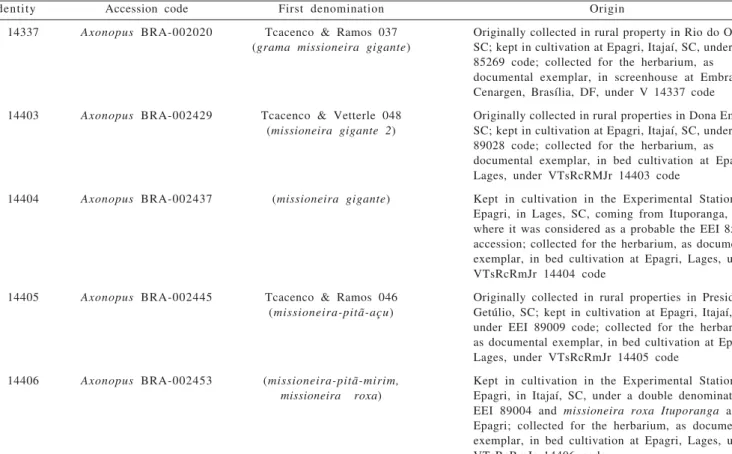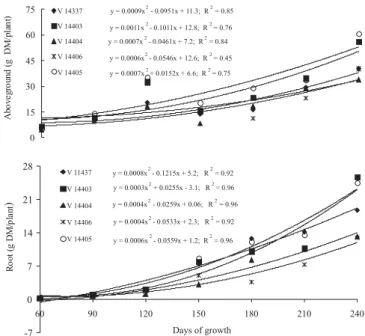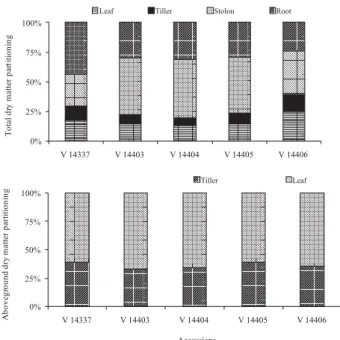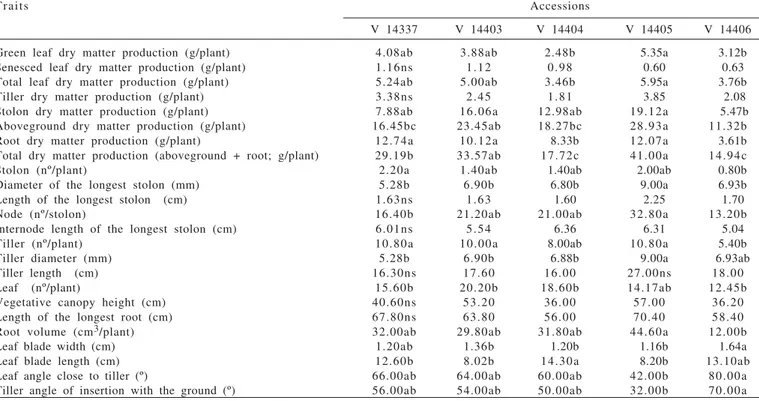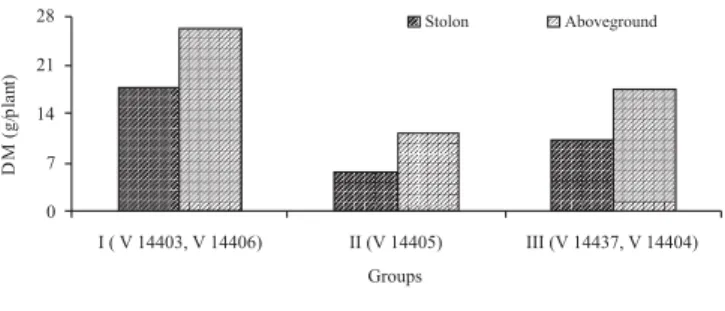Received December 27, 2010 and accepted April 13, 2011. Corresponding author: cjalus@unochapeco.edu.br
Morphophysiological characterization of giant missionary grass
accessions
1Cristiano Reschke Lajús2,3, Simone Meredith Scheffer-Basso4,5, Mario Miranda3,6, Rosiane Berenice Nicoloso Denardin2, José Francisco Montenegro Valls5,7
1Projeto financiado pelo CNPq.
2Universidade Comunitária da Região de Chapecó (Unochapecó).
3Programa de Pós-graduação em Agronomia, Universidade de Passo Fundo (UPF). 4Universidade de Passo Fundo.
5Pesquisador CNPq.
6Empresa de Pesquisa Agropecuária e Extensão Rural (Epagri). 7Embrapa Recursos Genéticos e Biotecnologia (Embrapa-Cenargen) .
ABSTRACT - In this study, the phenotypic diversity of five accessions of giant missionary grass (Axonopus jesuiticus × A. scoparius) was evaluated by using morphophysiological traits. Accessions V 14337, V 14403, V 14404, V 14405 and
V 14406 are hybrids derived from spontaneous crossing that occurred in Vale do Itajaí, Santa Catarina, Brazil. Plants were cultivated in greenhouse and evaluated at 60, 90, 120, 150, 180, 210 and 240 days of growth. Variation was observed for dry matter production, phenology and morphological traits, showing the possibility of selection. Flowering started at 210 days of growth and only in accessions V 14337 and V 14404. The Mahalanobis distance among accessions ranged from 35.64 (V 14403 and V 14405) to 183.38 (V 14337 and V 14405), and three groups were formed, based on 17 vegetative morphophysiological traits evaluated in plants with 180 days of growth: G1 (V 14403, V 14405), G2 (V 14406) and G3 (V 14337, V 14404). Group I presented the greatest dry matter production of stolon and aboveground, which were the traits with the largest relative contribution to genetic divergence, 38.67% and 38.31%, respectively. Accessions V 14403 and V 14405 are the most promising for agronomic evaluations that address their records as forage cultivars.
Key Words: A. catharinensis, dry matter production, growth analysis, phenology www.sbz.org.br
Introduction
The acquisition, characterization and evaluation of wild germplasm adapted to climate and soil of each region are fundamental for the continuing animal production on pasture, which is the predominant system in Brazil.
In a germplasm collection of forage plants maintained by the Empresa de Pesquisa Agropecuária e Extensão (Epagri), in Vale do Rio Itajaí, Santa Catarina, the introduction of Tcacenco/Ramos 037 (Axonopus spp.) prevailed for its
height, productivity and acid soil adaptation (Tcacenco & Soprano, l997). The grass is popularly known as missioneira-gigante, in this study called giant missionary grass, because
of its bigger size in relation to jesuit grass (Axonopus jesuiticus (Araújo) Valls).
The giant missionary grass is a triploid hybrid (2n = 3x = 30) resulting from natural crossing between A. jesuiticus
and A. scoparius (Flüggé) Kuhlm., and without viable
seeds because the cell meiosis does not produce perfect gametes (Valls et al., 2000). It is a stoloniferous plant, a trait inherited from A. jesuiticus, with branched inflorescence,
typical of A. scoparius, and it is vegetatively propagated.
It is also referred to as A. catharinensis Valls (Perez, 2008;
Probst et al., 2009); however, the publication of this new name is not formalized yet.
Researches have proven the forage potential of this grass related to dry matter production in warm season (11,700 kg DM/ha), and its nutritive value, with levels of up to 11.9% of crude protein and 70.3% of in vitro
digestibility of organic matter (Tcacenco, 1994; Tcacenco & Soprano, 1997). Dufloth (2002) stressed its high persistence, animal acceptability and the possibility of ensuring an average daily gain of 0.814 kg/animal.
The spontaneous hybridization between A. jesuiticus
× A. scoparius occurred in several opportunities, favoring
This study evaluated the divergence between accessions of giant missionary grass, guided by the assumption that there is variability in the germplasm, and that the morphophysiological traits enable its efficient characterization. The information can allow the development of a breeding program by indicating the most promising materials.
Material and Methods
The research was developed at the research station of Epagri, in Chapecó, Santa Catarina (27° 07' South and 52° 37' West), between August 2008 and April 2009. The climate of the region is Cfa type (Mota et al., l971) (Figure 1).
Five accessions of giant missionary grass (Table 1) were evaluated at 60, 90, 120, 150, 180, 210 and 240 days of continuous growth, using randomized complete block design, with five replications. Plants were grown in plastic pots filled with 0.5 kg (60, 90 and 120 days), 2.0 kg (150 and 180 days) and 4.0 kg (210 and 240 days) of dried substrate, according to the harvest age. The substrate (Ferticel®) presented the following attributes: pH = 7.1; dry matter content = 0.64%; N = 5.72 g/kg; P = 1.97 g/kg; K = 2.02 g/kg; Ca = 11.01 g/kg; Mg = 13.12 g/kg; Cu = 51.46 mg/kg; Zn = 45.80 mg/kg; Fe = 9863.70 mg/kg and Mn = 198.35 mg/kg.
Stolon cuttings, presenting one tillerwithabout 15 cm of height, two visible nodes, two fully expanded leaves and one expanding leaf, were planted in pots and placed on benches exposed to air under a polyethylene net to avoid rain or hail damages. Plants were watered twice a day, and pots, in each block, were rotated weekly to provide equal light condition to all plants, and minimize variation due to border effects. There was no need for fertilizers or chemical plant protection.
Plants were evaluated according to the following routine: plant height was measured at the highest point, between the ground and the curvature of the upper leaves (vegetative
Figure 1 - Mean monthly temperatures during the experimental and normal regional periods(thirty-year mean). Chapecó, Santa Catarina, Brazil.
Identity Accession code First denomination Origin
V 14337 Axonopus BRA-002020 Tcacenco & Ramos 037 Originally collected in rural property in Rio do Oeste,
(grama missioneira gigante) SC; kept in cultivation at Epagri, Itajaí, SC, under EEI
85269 code; collected for the herbarium, as documental exemplar, in screenhouse at Embrapa Cenargen, Brasília, DF, under V 14337 code
V 14403 Axonopus BRA-002429 Tcacenco & Vetterle 048 Originally collected in rural properties in Dona Emma,
(missioneira gigante 2) SC; kept in cultivation at Epagri, Itajaí, SC, under EEI 89028 code; collected for the herbarium, as documental exemplar, in bed cultivation at Epagri, Lages, under VTsRcRMJr 14403 code
V 14404 Axonopus BRA-002437 (missioneira gigante) Kept in cultivation in the Experimental Station at
Epagri, in Lages, SC, coming from Ituporanga, SC, where it was considered as a probable the EEI 85269 accession; collected for the herbarium, as documental exemplar, in bed cultivation at Epagri, Lages, under VTsRcRmJr 14404 code
V 14405 Axonopus BRA-002445 Tcacenco & Ramos 046 Originally collected in rural properties in Presidente
(missioneira-pitã-açu) Getúlio, SC; kept in cultivation at Epagri, Itajaí, SC, under EEI 89009 code; collected for the herbarium, as documental exemplar, in bed cultivation at Epagri, Lages, under VTsRcRmJr 14405 code
V 14406 Axonopus BRA-002453 (missioneira-pitã-mirim, Kept in cultivation in the Experimental Station at
missioneira roxa) Epagri, in Itajaí, SC, under a double denomination,
EEI 89004 and missioneira roxa Ituporanga at
Epagri; collected for the herbarium, as documental exemplar, in bed cultivation at Epagri, Lages, under VTsRcRmJr 14406 code
height) and tip of inflorescences (reproductive height). The angle of insertion of two peripheral opposite tillers to the ground was determined with a protractor, and after that, plants were removed from the pots. The length of the longest root was measured and the root system volume was determined by the water-level difference, after immersion in a graduated cylinder. The number of tillers was recorded, and in the longest tiller, the diameter of the second basal internode and the number of leaves were estimated. Stolons were counted and their length measured; the longest stolon was evaluated as for diameter of the second internode, counted from the plant insertion, number of nodes and internode average length. Leaf color (green, green-purple) was registered, and the second fully expanded leaf, counted from the tip to the base of the highest tiller, was evaluated as for blade width and its angle of insertion in the tiller. Inflorescences were characterized for length, branch number, length of the longest branch and spikelet number per branch. Roots, green and senesced leaves, stolons, tillers and inflorescences were dried in a forced ventilation oven at 60ºC during 72 h and weighed.
Data were submitted to split-plot analysis of variance (main plot: accessions; subplot: days of growth) and regression analysis, using the software package SISVAR (Ferreira, 2000). Means were compared using Tukey’s test at the 5% probability. Genetic divergence was evaluated by multivariate procedures, using 17 vegetative morphophysiological traits recorded in plants with 180 days of growth: Mahalanobis distance, relative importance of characters to genetic divergence, by Singh method (1981), and hierarchical clustering (UPGMA method). Multivariate analysis was performed using the software package Genes (Cruz, 2001).
Results and Discussion
Aboveground and root dry matter accumulation increased quadratically as function of growing days, with variation between accessions (Figure 2). In plants with 240 days of growth, the dry matter production of these components was 2.0 times greater for V 14403 and V 14405 accessions compared with the other ones. These accessions were also superior as for stolon dry matter accumulation (Figure 3).
In all accessions, the stolon dry matter production was late, only from 120 days, stabilized between 150 and 210 days of growth, followed by resumption of growth rate. The cubical trend observed for this attribute illustrated its rhythmic growth, which is common in stem structures (Barthélémy & Caraglio, 2007), and suggests a slow
establishment of the giant missionary grass. On the other hand, there is reference about its easy establishment and dominance over other species in pastures (Nascimento et al., 1990). This discrepancy is an important aspect to be considered in future field essays because, in this study, stolons went over the edge of the pots and their rooting was restricted. Lateral expansion is one of the most important traits for stoloniferous species, as it implies in soil recovering, competition with other species, efficiency in intercepting radiant energy, and, consequently, faster utilization by animals.
Plants showed significant allocation of dry matter in roots and stolons (Figure 4). Accession V 14337 presented the largest root allocation (43%), and the opposite was
Figure 2 - Aboveground and root dry matter accumulation of giant missionary grass accessions as for days of growth.
verified in V 14406 (24%). Nascimento et al. (1990) also reported the high root vigor of V 14337, which, among the hybrids of giant missionary grass, is the most cultivated in Santa Catarina. This feature must be a contributing factor to its high persistence under grazing (Dufloth, 2002) and acid soil tolerance (Tcacenco & Soprano, 1997).
Tropical grasses, in general, have expressive partitioning in subterranean structures, as it was pointed out by Grise et al. (2006) in cv. Pensacola (Paspalum notatum Flüggé), which allocated between 4 and 12 times
more dry matter in roots + rhizomes in relation to aboveground. In the present study, the dry matter partitioning in leaves and tillers was 17% and 10% of total dry matter at 240 days of growth, respectively (Figure 4). In aboveground, these components represented 60% and 40% of dry matter, respectively, which it is excellent, considering the advanced plant age. This aspect suggests the aptitude of this grass, also, for hay production and deferment.
The relationship between leaf dry matter accumulation and days of growth was linear to accessions V 14337 and V 14403 and quadratic to the other ones (Figure 5). Maximum leaf production was recorded in V 14405 (10 g DM/plant) and the minimum occurred in V 14404 (5.9 g DM/plant), which also presented the smallest leaf senescence (26%) (Figure 6). In accessions V 14337 and V 14405, senescence reached the highest values, of 39% and 42%, respectively, suggesting variability in the morphogenesis. Santos (2005)
Figure 4 - Partitioning of total (aboveground + roots) and aboveground (leaves + tillers) dry matter of giant missionary grass accessions at 240 days of growth.
Traits V 14337 V 14404
Reproductive canopy height (cm) 76.28a 42.85b
Reproductive tiller length (cm) 74.28a 17.14b
Branch number/inflorescence 13.42a 2.85b
Longest branch length (cm) 9.71a 3.14b
Spikelet number/longest branch 24.57a 7.71b
Inflorescence dry matter production 0.15a 0.05a
(g DM/plant)
Means followed by same letter in the row do not differ (P>0.05) by Tukey test.
Table 2 - Reproductive morphophysiological traits of two giant missionary grass accessions
registered high leaf durability in this grass (accession not mentioned), which was above 1,000 degrees/day (basal temperature = 0ºC).
Accessions varied in relation to phenology, since flowering was only observed in accessions V 14337 and V 14404, from 210 days of growth. These materials exhibited differences as for reproductive canopy height and inflorescence morphological traits (Table 2), except for inflorescence dry matter production, which was negligible. However, through cluster analysis, which considered only the vegetative characters, these materials remained in the same group (Figure 7). In the dendrogram generated by
Figure 5 - Leaf dry matter accumulation of giant missionary grass accessions as for days of growth.
UPGMA method, assuming 50% of relative distance among accessions, three groups were formed: group I: V 14403 and V 14405 (D2 = 35.64), group II: V 14406 and group III: V 14337 and V 14404 (D2 = 56.36). The greatest divergence
was verified between V 14337 and V 14405 (D2 = 183.38). Considering the traits with the highest relative contribution for genetic divergence (Table 3), stolon and aboveground dry matter production, the clustering was very consistent and expressed the accession yield performance. Group I was the most productive, and the opposite characterized the group II (Figure 8). The only accession that formed group II, V 14406, stood out from the others by its upright growth habit, demonstrated by greater angle of tiller insertion with the ground (Table 4), as well as by color leaf, which is green-purple. These attributes are characteristic of A. scoparius (Lima et al., 2001;
Giraldo-Cañas, 2008), one progenitor of this hybrid.
Figure 7 - Dissimilarity dendrogram of five giant missionary grass accessions obtained by UPGMA method, based on Mahalanobis distance, using 17 vegetative morphophysiological traits evaluated in plants with 180 days of growth. Cutting point = 50% of relative distance.
Means followed by the same letter in the row do not differ (P>0.05) by Tukey test; ns = not significant.
Traits Accessions
V 14337 V 14403 V 14404 V 14405 V 14406
Green leaf dry matter production (g/plant) 4.08ab 3.88ab 2.48b 5.35a 3.12b
Senesced leaf dry matter production (g/plant) 1.16ns 1.12 0.98 0.60 0.63
Total leaf dry matter production (g/plant) 5.24ab 5.00ab 3.46b 5.95a 3.76b
Tiller dry matter production (g/plant) 3.38ns 2.45 1.81 3.85 2.08
Stolon dry matter production (g/plant) 7.88ab 16.06a 12.98ab 19.12a 5.47b
Aboveground dry matter production (g/plant) 16.45bc 23.45ab 18.27bc 28.93a 11.32b
Root dry matter production (g/plant) 12.74a 10.12a 8.33b 12.07a 3.61b
Total dry matter production (aboveground + root; g/plant) 29.19b 33.57ab 17.72c 41.00a 14.94c
Stolon (nº/plant) 2.20a 1.40ab 1.40ab 2.00ab 0.80b
Diameter of the longest stolon (mm) 5.28b 6.90b 6.80b 9.00a 6.93b
Length of the longest stolon (cm) 1.63ns 1.63 1.60 2.25 1.70
Node (nº/stolon) 16.40b 21.20ab 21.00ab 32.80a 13.20b
Internode length of the longest stolon (cm) 6.01ns 5.54 6.36 6.31 5.04
Tiller (nº/plant) 10.80a 10.00a 8.00ab 10.80a 5.40b
Tiller diameter (mm) 5.28b 6.90b 6.88b 9.00a 6.93ab
Tiller length (cm) 16.30ns 17.60 16.00 27.00ns 18.00
Leaf (nº/plant) 15.60b 20.20b 18.60b 14.17ab 12.45b
Vegetative canopy height (cm) 40.60ns 53.20 36.00 57.00 36.20
Length of the longest root (cm) 67.80ns 63.80 56.00 70.40 58.40
Root volume (cm3/plant) 32.00ab 29.80ab 31.80ab 44.60a 12.00b
Leaf blade width (cm) 1.20ab 1.36b 1.20b 1.16b 1.64a
Leaf blade length (cm) 12.60b 8.02b 14.30a 8.20b 13.10ab
Leaf angle close to tiller (º) 66.00ab 64.00ab 60.00ab 42.00b 80.00a
Tiller angle of insertion with the ground (º) 56.00ab 54.00ab 50.00ab 32.00b 70.00a
Table 4 - Vegetative morphophysiological traits of giant missionary grass accessions, at 180 days of growth
Traits R.C.G.D (%)
Green leaf dry matter production (g/plant) 5.76
Senesced leaf dry matter production (g/plant) 1.10
Tiller dry matter production (g/plant) 1.78
Stolon dry matter production (g/plant) 38.67
Aboveground dry matter production (g/plant) 38.31
Root dry matter production (g/plant) 0.044
Total dry matter production (aboveground + 6.08
root; g/plant)
Stolon (nº/plant) 0.16
Diameter of the longest stolon (mm) 1.37
Length of the longest stolon (cm) 0.66
Node (nº/longest stolon) 0.53
Internode of the longest stolon (cm) 0.22
Vegetative canopy height (cm) 0.35
Tiller (nº/plant) 1.10
Leaf (nº/plant) 2.26
Leaf blade width (cm) 0.25
Leaf blade length (cm) 0.17
The morphophysiological traits used to characterize the giant missionary grass accessions showed that there is variability in the germplasm (Table 4), which credits its evaluation in field experiments, to describe the variation for attributes of agronomic importance (Jaramillo & Baena, 2000). The new information about the accessions can contribute to their conservation, use and management, offering subsides to the species breeding program.
Conclusions
Morphophysiological traits are efficient to evaluate the variability in the giant missionary grass accessions, which vary as for growth habit, morphology, dry matter accumulation and phenology. Accessions V 14337 and V 14404 are earlier for flowering, and V 14403 and V 14405 are the most promising to further agronomic evaluation aiming at cultivar registration.
References
BARTHÉLÉMY, D.; CARAGLIO, Y. Plant architecture: a dynamic, multilevel and comprehensive approach to plant form, structure and ontogeny. Annals of Botany, v.99, p.375-407, 2007. CRUZ, C.D. Programa Genes Versão Windows: Aplicativo
computacional em genética e estatística. Viçosa, MG: Editora UFV, 2001. 648p.
DUFLOTH, J.H. Missioneira gigante: uma nova opção na produção do novilho precoce. Agropecuária Catarinense, v.15, n.2, p.23, 2002.
FERREIRA, D.F. Sistema de análises de variâncias para dados balanceados – SISVAR 4.1. Lavras: Editora UFLA, 2000. 141p. GIRALDO-CAÑAS, D. Revisión del género Axonopus (Poaceae:
Paniceae): primer registro del género en Europa y novedades taxonómicas. Caldasia, v.30, n.2, p.301-314, 2008. GRISE, M.M.; SOLLENBERGER, L.; DUBEUX, J.R. et al.
Partição da biomassa e qualidade da forragem de Bahiagrass;
Paspalum notatum cv. Pensacola no centro-norte da Flórida. A c t a S c i e n t a r u m A n i m a l S c i e n c e, v.28, n.4, p.375-383, 2 0 0 6 .
JARAMILLO, S.; BAENA, M. [2000]. Material de apoyo a la capacitación en conservación e x s i t u de recursos fitogenéticos. IPGRI, Cali, Colômbia, 209p. Available at: <http://www.ipgri.cgiar.org> Accessed on: Jun. 5, 2011. LIMA, L.M.S.; ALQUINI, Y.; BRITO, C.J.F.A. et al. Área de tecidos
de folhas e caules de Axonopus scoparius (Flügge) Kuhlm. e
Axonopus fissifolius (Raddi) Kuhlm. Ciência Rural, v.31, n.3, p.425-430, 2001.
MOTA, F.S.; BEIRSDORF, F.; GARCEZ, J.R.B. Zoneamento agroclimático do Rio Grande do Sul e Santa Catarina - Normais agroclimáticas. Pelotas: Ministério da Agricultura, 1971. 80p. NASCIMENTO, J.A.L.; FREITAS, E.A.G.; DUARTE, C.M.L. A
grama missioneira no Planalto Catarinense: produção de forragem, valor nutritivo e ganho de peso nas condições de manejo do produtor. Florianópolis: Empasc, 1990. 65p (Boletim Técnico, 52).
PEREZ, N.B. [2008]. Multiplicação vegetativa de plantas forrageiras: recomendações para plantio. Bagé: Embrapa Pecuária Sul, 2008. (Documentos/Embrapa Pecuária Sul, 73). Available at: <http://www.cppsul.embrapa.br/unidade/publicacoes> Accessed on: Dec. 21, 2010.
PROBST, R.; QUADROS, S.A.F.; ERPEN, J.G. et al. Produção de mudas de espécies forrageiras no sistema hidropônico de leito flutuante (f l o a t i n g) com solução nutritiva à base de biofertilizante ouadubo solúvel. Acta Scientiarum, v.31, n.4, p.349-355, 2009.
SANTOS, R.J. Dinâmica de crescimento e produção de cinco gramíneas nativas do sul do Brasil. 2005. 110f.Dissertação (Mestrado em Zootecnia) – Faculdade de Agronomia/Universidade Federal do Rio Grande do Sul, Porto Alegre.
SINGH, J. The relative importance of characters affecting genetic divergence. The Indian Journal of Genetic and Plant Breeding, v.41, n.2, p.237-245, 1981.
TCACENCO, F.A. Avaliação de forrageiras nativas e naturalizadas, no Vale do Itajaí, Santa Catarina. Pesquisa Agropecuária Brasileira, v.29, n.3, p.475-489, 1994.
TCACENCO, F.A.; SOPRANO, E. Produtividade e qualidade da grama missioneira [A x o n o p u s j e s u i t i c u s (Araújo) Valls] submetida a vários intervalos de corte. Pasturas tropicales, v.19, n.3, p.28-35, 1997.
VALLS, J.F.M.; SANTOS, S.; TCACENCO, F.A. et al. A grama missioneira gigante: híbrido entre duas forrageiras cultivadas do gênero Axonopus (Gramineae). In: CONGRESSO NACIONAL D E G E N É T I C A , 4 6 . , 2 0 0 0 , Á g u a s d e L i n d ó i a . A n a i s . . . Águas de Lindóia: Sociedade Brasileira de Genética, [2000]. (CD-ROM).
